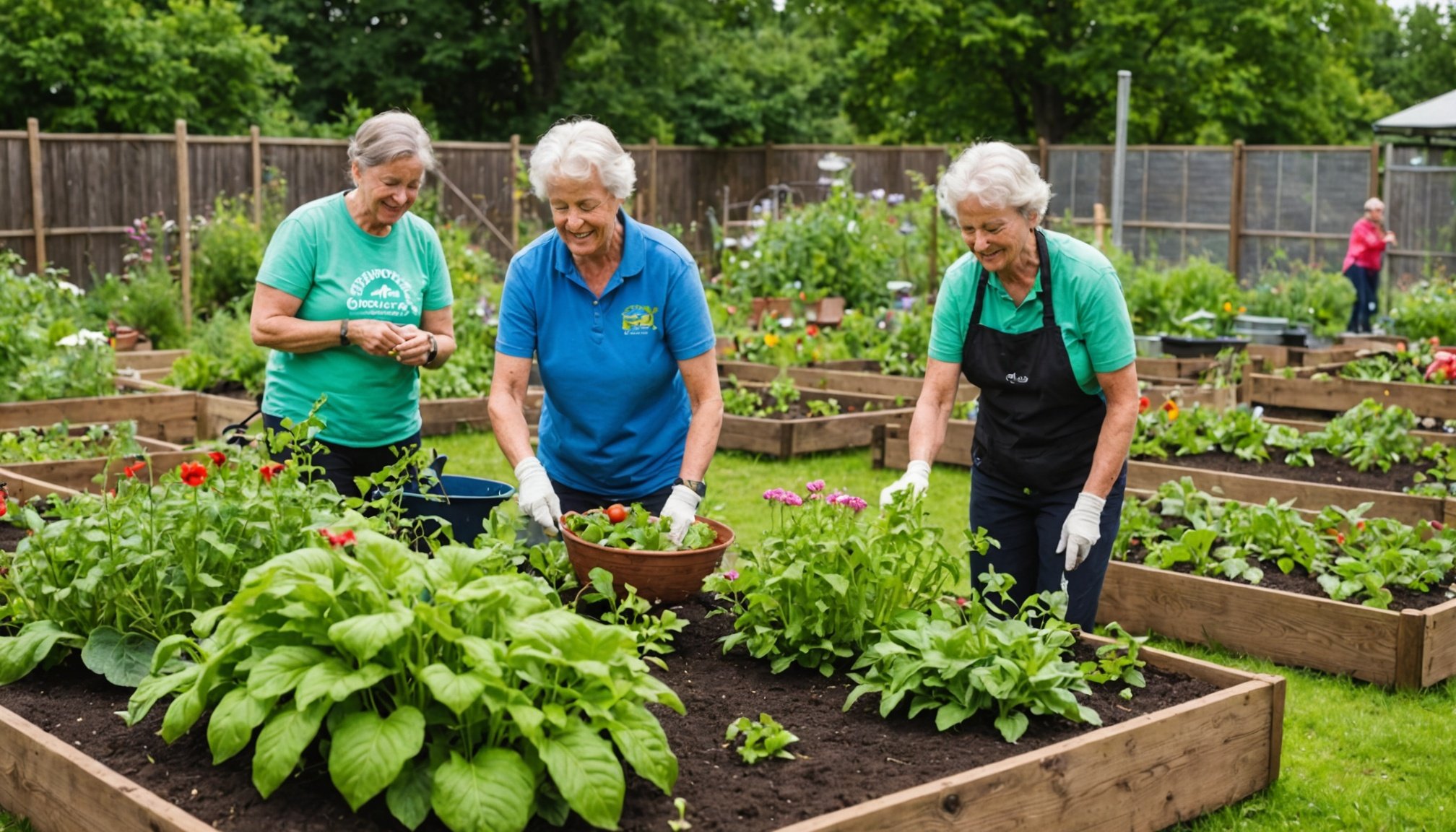Overview of Community Gardens
Community gardens have long served as a hub for fostering social bonds and improving mental health. Historically, these gardens have existed to meet both practical needs, such as food production, and emotional ones, offering a serene refuge within bustling urban landscapes. They represent more than just plots of land; they are vital spaces where individuals come together to cultivate not only plants but also relationships and community spirit.
In urban environments, where green spaces may be limited, community gardens play a crucial role. They offer residents the chance to engage with nature, directly impacting their daily lives and neighbourhoods positively. These gardens support diverse plant cultivation, allowing for both ecological benefits and personal growth through shared experiences.
Topic to read : Boosting Senior Minds: The Surprising Benefits of Classical Music on Memory and Cognitive Function
The concept of community gardens traces back centuries, experiencing modern resurgence as urban populations recognize their value. With people keen to reconnect with nature and their communities, these spaces are designed with inclusivity in mind, thus promoting social interaction and reinforcing community ties. By fostering an environment of cooperation and shared responsibility, they become instrumental in knitting together the fabric of diverse communities.
Mental Health Benefits
Community gardens are more than just a sanctuary for plants; they greatly enhance our psychological well-being. Engaging in gardening has been shown to significantly relieve stress. Studies suggest that being active in such green spaces can reduce symptoms of anxiety and depression. The act of gardening itself, involving physical activity, plays a vital role in boosting mental health by releasing endorphins, which are natural mood lifters.
Also to see : Boosting Bonds: The Impact of Pet-Assisted Therapy on Social Skills in Children with Autism
But research is not the only source highlighting these benefits. Consider the personal testimonies from community garden participants. Many have reported a tangible sense of peace and satisfaction when tending to a garden, mentioning how this activity becomes therapeutic over time. One participant expressed it as a “calm escape” from their daily routine.
Gardening not only caters to the cultivation of plants but also nurtures the mind. Through these experiences, gardens become a natural therapy zone, encouraging regular interaction with nature. Such activities provide an emotional outlet that contributes to long-lasting mental health improvements. Gardening is an effective, accessible means to enhance both physical and psychological health, fostering an environment where residents can thrive together amid the greenery.
Social Interaction and Community Building
Community gardens are fertile ground for cultivating social connections and enhancing community engagement. These spaces naturally bring diverse groups of people together, sparking friendships and nurturing a sense of belonging. Community gardens act as social magnets, drawing in individuals who may not usually interact. As gardeners collaborate on planting and maintenance tasks, they form bonds through shared experiences and collective goals.
To further foster inclusivity and diversity, gardens can implement welcoming strategies such as inclusive design and multicultural events. Gardens that host workshops on different gardening techniques or cultural festivals can attract wider participation, thus strengthening community ties.
Case studies illustrate the powerful role community gardens play in relationship building. For example, in some urban settings, gardens have been pivotal in bringing together different ethnic groups, creating a harmonious and integrated community. These examples highlight how gardens are not just about horticulture, but pivotal in building cohesive communities through social interactions.
Through structured activities or informal get-togethers, community gardens are proving their value as vibrant hubs where friendships blossom and communities flourish, reinforcing bonds that extend well beyond the garden’s borders.
Expert Opinions and Research Insights
Community gardens have garnered considerable attention from professionals specialising in psychological research and sociology. Renowned experts, including psychologists and sociologists, emphasise the multifaceted benefits that these green spaces offer. Interviews with these specialists reveal that community gardens reinforce both social bonds and individual well-being, significantly contributing to a community’s overall cohesion and resilience.
Recent studies have provided compelling insights into how community gardens affect diverse demographics. These studies highlight the remarkable positive changes in mental health, echoing the reduction in anxiety and depression found in individuals actively involved in gardening. The tangible impacts on community ties are equally notable. Reports consistently show that gardens help weave a stronger social fabric among participants.
The intersection of community impact and psychological benefits is further emphasised through scholarly highlights. These insights underscore the crucial role gardens play in strengthening communities, particularly in urban zones where traditional social bonds might be weaker. The cumulative research confirms that beyond trimming hedges and tilling soil, community gardens are platforms for creating meaningful relationships and fostering a sense of belonging. Engaging in garden activities is proving to be a catalyst for both personal and community growth.
Actionable Tips for Starting or Joining Community Gardens
Embarking on a community garden project might seem daunting, but it can be incredibly rewarding. Here’s a step-by-step guide to get you started:
-
Identify a suitable location: Look for available plots of land within your community. Check with local councils or landowners for permission.
-
Form a group of interested individuals: Reach out to neighbours and friends who share a passion for gardening. The more, the merrier, as community involvement is vital for success.
-
Draft a plan: Collaborate on a layout. Decide on plant types and assign responsibilities to ensure the smooth operation of the garden.
Resources are abundant for those serious about launching or joining a community garden. Organizations such as community gardening networks provide guidance and support throughout the process. Their expertise can be instrumental in overcoming challenges.
Engaging community members is crucial for sustained interest and participation. Implement inclusive activities like workshops and garden-themed events to foster engagement. Diverse ways of involvement can attract more participants, ensuring that the garden remains a lively hub of activity. By following these actionable tips, anyone can cultivate a thriving community focal point.
Visual and Personal Story Integration
Community gardens flourish through the power of personal experiences and vivid visual storytelling. Highlighting individual stories humanises the gardening journey, transforming abstract benefits into relatable narratives. Integrating vibrant photography and videos not only captivates but also illustrates how these communal spaces foster deep relationships and community involvement.
Visuals are a potent tool for showcasing the intangible aspects of community gardening. A series of before-and-after images can strikingly depict the transformation of a barren plot into a thriving community oasis. Videos capturing moments of collaboration during planting events highlight the meaningful interactions and joy shared among participants.
Personal stories of gardeners reveal unique insights into how engaging with gardens has enriched their lives. A novice gardener might share how tending the soil eased their stress, while a seasoned participant might recall friendships forged over sowing seeds. Such testimonials resonate on an emotional level, encouraging others to join or establish their own community gardens.
Utilising visual storytelling and personal narratives enhances community involvement, painting a comprehensive picture of the varied positive impacts gardens provide. These stories are not merely about gardening; they celebrate resilience, connection, and the joy of growth within the community.




